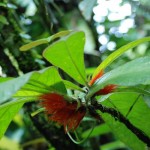Costa Rica Braulio Carrillo National Park
Braulio Carrillo National Park is located northeast of the Central Valley of the Central Volcanic Cordillera, between Poas and Irazu beds. Includes Black and Barba volcanoes Cacho, from the Alto de la Palma (Moravia) in the La Selva Biological Station (Sarapiquí). It was created by Law No. 8357-A, April 5, 1978. Its extension is of 45.899.2 hectares.
This park is dedicated to the Hero of the Nation, Mr. Braulio Carrillo, third Head of State of Costa Rcia (1835-37 and 1838-42), who tracked the efforts to open a road connecting the Central Valley to Matina, in the the Atlantic coast.
This area is located in a zone of irregular topography of the country.
The landscape consists of high mountains densely covered with forests and many rivers. The topography and high rainfall, about 4,500 mm per year on average, result in the formation of countless waterfalls.
Parks extinct volcanoes continent. The Black Cacho, very remarkable for its conical shape, and Barva with several craters, Laguna Barva, circular, about 70 meters in diameter and clear water lagoon and Danta, about 500 meters in diameter. The Three Marias clearly observads hills from San Jose, are the remains of a structure that existed there caldérica.
The park’s vegetation is the evergreen forest of great density and botanical complexity. The forest presents variations in different environmental conditions, topography, drainage, temperature, cloudiness and precipitation.
The highest forests and greater wealth of species found in the lowlands, in the highest parts and broken trees are shorter and deformed and the total number of species is lower. Most of the park is covered by primary forest, which Exiten some 6,000 species of plants representing half of all species throughout the country. The Manu, mahogany, oak, and gavillán caobilla are relatively abundant.
They are also the botarrama, ceiba, the yos, parrot and ojoche; other species, however, are in danger of extinction, like the Nazarene, pumpkin, saw palmetto and sweet súrtuba. In the upper parts of the park, specifically the Barva Volcano, the flora is characteristic of cloud forest, known as the ciprecillo species, candelillo, white oak and cedrillo.
The park offers a great diversity of wildlife. Highlights the rich avifauna represented in almost 515 species of resident and migratory birds. Observed the king vulture, the umbrella bird, the goldfinch and the quetzal.
Among the species of mammals are howler monkeys, white face and red and the tapir, puma and jaguar, peccary, the bear beekeeper, the hammer, the ibex, the blonde and coyote. There are also species that threaten to extinguierse hunting, as in the case of the peacock and the tepezcuinte.
Frogs and toads are abundant in the area. Located in the Barva Volcano, an endemic species, the toad Bufo holdridgei. A reptile existing in the park is the bushmaster, the largest venomous snake in Africa.

